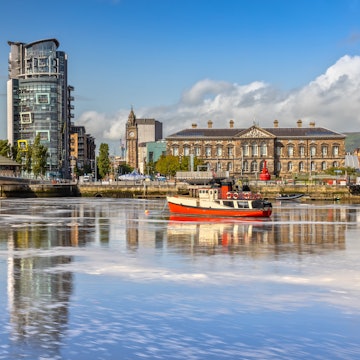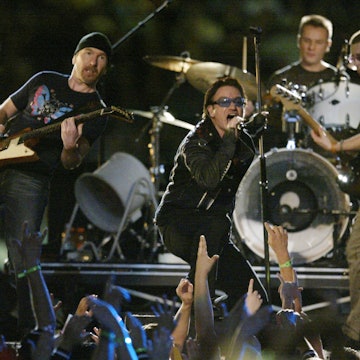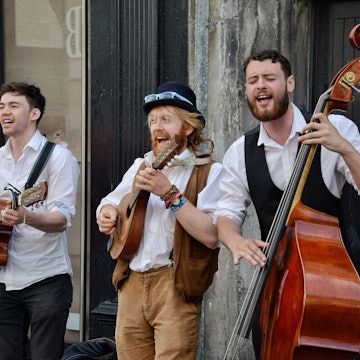
You'll see this everywhere: traditional Breton music and dancing

Jul 15, 2024 • 5 min read

Traditional singing and dancing are at the heart of Breton culture. Elena Dijour / Shutterstock
It can be pretty intimidating to get involved with the Bretons once they hear the sound of a bagpipe — which usually sees them gather in a circle, lock pinkies, and set off for a little bit (or a whole night) of traditional dancing.
But it’s not that scary at Lorient’s Interceltic Festival.
A yearly event that gathers almost a million visitors and thousands of musicians and dancers from Celtic regions like Scotland, Ireland and of course, Brittany, the festival is a joyful celebration that is open to all. As I made my way from a street performance by Asturian musicians to one of the main stages to listen to an up-and-coming Breton band, I could have never anticipated that I’d find myself, hands locked on both sides with total strangers, in a large round of dancers expertly jumping from one side to the other.
Perhaps it was the couple of local beers I’d had earlier with my moules frites (mussels and fries), or the fact that both musicians and spectators patiently showed the steps to those who were novices. But even as a born and bred Parisian, I had never felt more like I got it.

Why is traditional music and dancing so important in Brittany?
It’s difficult for anyone who is not from Brittany to fully grasp how important traditional singing and dancing are to the region. Of course, they are visible everywhere — from Friday evening gigs at the local bar to region-wide music and dance championships. But beyond the fun, they are also one of the essential ways in which the Bretons have defended their identity over the centuries.
Breton music and dance go back to the Middle Ages, and find their roots in Celtic tradition. As early as the 14th century, Breton sonneurs appeared — local musicians who typically played wind instruments like the bombard, a type of oboe, and the biniou, which is similar to the bagpipes. Sonneurs would play for people to dance at all kinds of social and religious events like weddings and threshings; as they multiplied through the centuries, they became a central piece of everyday Breton life.
By the 19th century, Brittany had a rich and lively music and dance scene that some intellectuals began to theorize constituted key components of a Breton culture — a claim to identity that came just as the French state started cracking down on "regional languages," including Breton language, which were banned from schools.
Traditional music and dance were progressively abandoned by the Bretons in the first half of the 20th century. The region’s thriving culture, which was perceived to be despised by the central state, suffered a setback — a decline that worsened in the immediate aftermath of the wars.
But a new major period of revivalism started in the 1950s; as musicians and dancers took a fresh interest in Breton history and identity, a "cultural revolution" began. Influential artists like Alan Stivell revisited and modernized traditional Breton songs; the bagad appeared — a modern type of sonneurs, except in a band — and so did the fest-noz, a type of party that intended to recreate the festive dancing events from the previous century.
This, incidentally, is also when Breton language started making a comeback. The national ban on regional languages was lifted in 1951; and the 1970s saw the launch of organizations like Diwan, which runs bilingual French-Breton schools across the region.

Where to experience traditional Breton music and dance today
Today, traditional singing and dancing are ubiquitous in Brittany. As art forms, they have evolved greatly, often merging with modern styles like rock and electro, and integrating techniques from around the globe. If you’re paying attention, it’ll be hard to miss your chance to experience Breton music and dance: in pretty much every town and village, particularly in the summer, there is bound to be some kind of local event that features a bagad or a fest-noz.
Any opportunity is good to take out the bagpipes and dance. Check out what’s on for Bastille Day on July 14; you’ll most likely find an open-air dance, some traditional singing, crêpe stands and fireworks. It’s the same deal on August 15, when towns on the coast celebrate the sea (Fête de la Mer), typically with a local fest-noz.
It’s worth a detour to the tourist office to find out if a fest-noz is scheduled during your stay, or if the local bagad and dance groups put on any regular events. In Quimper, for example, every Thursday evening throughout July and August, a free performance called Derrière les Remparts is organized by a bagad and a dance circle.

Bands that describe themselves as Celtic or Breton, like electro-trad quartet Herriwenn, Celtic punk rock band Les Ramoneurs de Menhirs and rock’n’roll group Soldat Louis, now abound, playing in fest-noz, bars, festivals and concert halls — so keep an eye out for their tour dates.
Without doubt the most straightforward way to experience traditional music and dance in Brittany, however, is to book yourself into one of the quintessentially Breton festivals that are put on year-round. Lorient’s Interceltic Festival is only one of many. Among Brittany’s flagship events, you’ll also find the Cornouaille Festival in Quimper, which celebrates Breton culture in all shapes and forms — music, dance, costume, food, drink and even language.
In November in Rennes, Yaouank music festival — which describes itself as the region’s biggest fest-noz — mixes Breton, world and contemporary music; while Tradi’Deiz in April in Vannes sees thousands of professional dancers and musicians parading in the city’s streets. Pont-Aven’s century-old Festival of Gorse Flowers, which every year elects a festival queen based on costume, dancing and music abilities, also comes with its load of fest-noz and traditional music concerts.
Like what you hear? Make sure you travel with cash, as most artists will be selling their album and some branded merch for you to take back. As soon as you hear the first notes of a bombard or bagpipe playing from your speaker at home, you’ll be taken right back to the moment when you looked a random person in the eye, grabbed their pinky, did some kicks and jumped sideways rhythmically while the singer shouted the beats out for you. You may have felt like you were getting it all wrong; but it’s well worth the experience and winning the heart of the Bretons.















